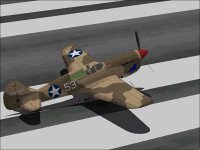Curtiss P40F 87D Kittyhawk MK.II
includes a great panel
A beautiful representation
A Fantastic Flight Model
Authentic Air and DP files
Hello No Dice,
Thanks for the enthusiastic description.
Here is a little explanation for the naming of this aeroplane:
United States called them all P-40.
P for Pursuit.
The specific model number is P-40F
This aeroplane came into service before Block Numbers were in use, otherwise it might have been known at a later date as a
P-40F-1-CU
F being the subtype,
-1 being the production Block Number
-CU indicating Curtiss construction as opposed to license built by another manufacturer.
Curtiss generally named its aircraft Hawk-something.
One of their biplane fighters used in China was the Curtiss Hawk III
The Hawk 75 became the P-36 in US Army service.
Early P-40s were the Hawk 81.Beginning with the P-40D they were called Hawk 87 and that remained true to the end of production in 1944.
The Hawk 87 was produce in many series starting with the Hawk 87A and ending with the Hawk 87W
Up through the P-40C, there was no official name for the US Army other than P-40.
Beginning with the P-40D or P-40E, the name "Warhawk" was used by the US Military.
The British didn't follow the American naming convention.
P-40s up to the C model equivalent were called the "Tomahawk".
Beginning with the P-40D, the British gave it the name "Kittyhawk".
As with other aircraft in British service, the subtype was indicated by a Mark number thus
the P-40D was equivalent to the Kittyhawk Mk.I
The P-40E was equivalent to the Kittyhawk Mk.IA
The P-40F was equivalent to the Kittyhawk Mk.II
I say equivalent because the different services called for slightly different equipment installations.
The two services also used different serial numbers, and only when an aircraft was transferred from one national service to the other would a single aircraft carry both kinds of serial numbers.
The only real unique "serial" number that was common to both would be the Curtiss Construction number which remained sequential between all customers....
So.... After all that long winded explanation, the proper title for this aeroplane should be either
Curtiss Hawk 87D
Curtiss P-40F Warhawk
Curtiss Kittyhawk Mk.II
....
I mix it up a bit and call it
Curtiss P-40C Hawk 87D Warhawk or Kittyhawk Mk.II
Hope that makes sense.
- Ivan.








